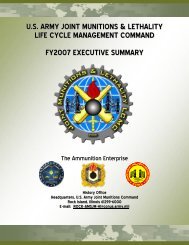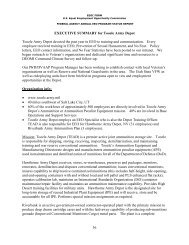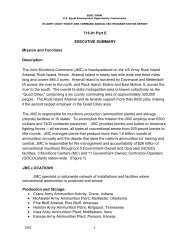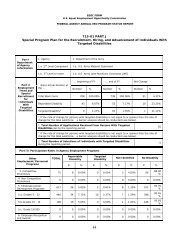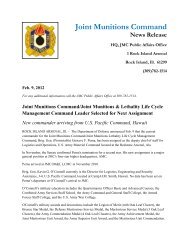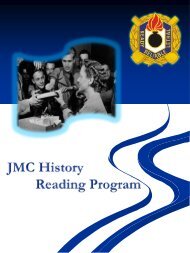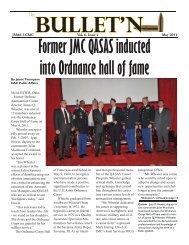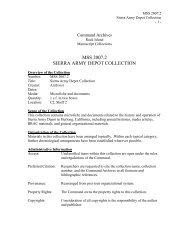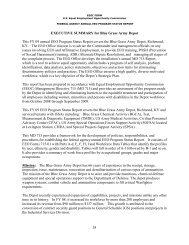History of the Ammunition Industrial Base - JMC - U.S. Army
History of the Ammunition Industrial Base - JMC - U.S. Army
History of the Ammunition Industrial Base - JMC - U.S. Army
Create successful ePaper yourself
Turn your PDF publications into a flip-book with our unique Google optimized e-Paper software.
first budget supplemental and U.S. Forces were confined within <strong>the</strong> Pusan Perimeter; he<br />
indicated that <strong>the</strong>y had only asked for extra funding through December 1950 because <strong>the</strong> war<br />
would be over by <strong>the</strong>n. Defense Department planners cut <strong>the</strong> Ordnance Department‟s request for<br />
ammunition by $2.4 billion to $374 million. Similar cuts happened with <strong>the</strong> third supplemental,<br />
formulated in November - December 1950, when <strong>the</strong> DoD again expected <strong>the</strong> war to be over by<br />
June 1951. Not until mid-1951 did Congress and DoD realize <strong>the</strong>re were problems with<br />
ammunition production and significantly increased ammunition funding. 55 Due to lead time<br />
issues, this money did not produce significant quantities <strong>of</strong> ammunition until 1952.<br />
Part <strong>of</strong> <strong>the</strong> problem with obtaining ammunition funding was convincing DoD, and even<br />
<strong>Army</strong> leadership, that all types <strong>of</strong> rounds needed procurement. The OD had a longer view over<br />
<strong>the</strong> ammunition situation than <strong>the</strong> <strong>Army</strong> and DoD leadership. The OD recognized need for<br />
increased production across all rounds. To accomplish this, <strong>the</strong> Chief <strong>of</strong> Ordnance wanted to<br />
create a balanced war reserve in addition to meeting <strong>the</strong> immediate needs for Soldiers in Korea.<br />
Because <strong>of</strong> his wider vision, he asked for significantly larger amounts <strong>of</strong> funding than <strong>Army</strong> or<br />
DoD was willing to provide. <strong>Army</strong> and DoD only saw <strong>the</strong> amount <strong>of</strong> WWII excess ammunition.<br />
They did not grasp <strong>the</strong> details <strong>of</strong> inventory balance by family and weapons type. Not until late<br />
1951 did DoD understand <strong>the</strong> need for a systemic plan for ammunition production for combat<br />
and replenishment, and this was only after most stock in Europe had been reduced below safety<br />
levels and rounds transferred to Korea. 56<br />
The Korean War also impacted <strong>the</strong> commercial ammunition industry. <strong>Army</strong> GOCO LAP<br />
plants required commercially and government produced components. The problems at <strong>the</strong><br />
GOCO plants had been partially addressed, but problems were more pronounced in <strong>the</strong><br />
commercial base. Unlike in <strong>the</strong> 1930s, U.S. commercial industry was operating at high capacity<br />
in 1950. Low levels <strong>of</strong> ammunition production after WWII had forced producers to convert to<br />
commercial consumer goods in order to turn a pr<strong>of</strong>it. Any ammunition peculiar plant machinery<br />
had been placed aside, removed, or converted. Personnel had been laid <strong>of</strong>f. Without a<br />
declaration <strong>of</strong> war in 1950, or any government call for mobilization, industry was not inclined to<br />
turn from pr<strong>of</strong>itable commercial production to limited pr<strong>of</strong>its in a boom or bust ammunition<br />
industry. 57<br />
The machine tool industry, which had vastly expanded in WWII, collapsed because <strong>of</strong><br />
significant over capacity in <strong>the</strong> late 1940s. After WWII, <strong>the</strong> OD transferred or sold most <strong>of</strong> <strong>the</strong><br />
ammunition machinery and tools to commercial entities at well below market value. In <strong>the</strong> late<br />
1940s <strong>the</strong> machine tool industry consolidated or converted to o<strong>the</strong>r production. The OD<br />
collected o<strong>the</strong>r machinery to create a National <strong>Industrial</strong> Plant Reserve. However, as later events<br />
revealed, most <strong>of</strong> this machinery was worn out. The arsenals had cannibalized <strong>the</strong> good<br />
equipment and most <strong>of</strong> what remained could not maintain production. In effect, <strong>the</strong> government<br />
had dumped supply onto <strong>the</strong> market and had undercut <strong>the</strong> very industry most required to restart<br />
<strong>the</strong> ammunition base. 58<br />
In <strong>the</strong> 1950s, as <strong>the</strong> OD began to place orders for machinery or place orders with<br />
commercial entities that required new machinery, <strong>the</strong> machine tool industry over-committed.<br />
55 Reeder, III-10 to III-15 and V-10.<br />
56 Ibid, II-8 – II-11 and Section III.<br />
57 Reeder, 7.<br />
58 Ibid, Section III.<br />
21



